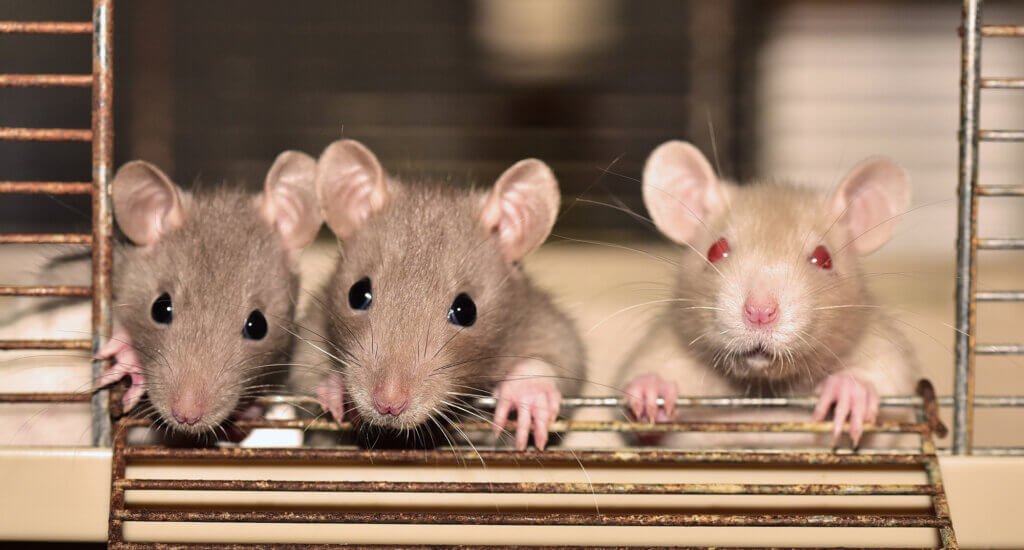Can an Animal Kept in a Cage Be a Reliable Model of Human Disease?
Written by Kati Bertrand
March 2023

According to the 2021 estimate by Dr. Larry Carbone, who specializes in animal welfare and laboratory animal medicine, at least 111.5 million rats and mice are used in experiments worldwide each year. A quick search through the PubMed database returns more than 40,000 papers discussing mouse models and more than 16,000 papers discussing rat models from 2022 alone. The vast majority of experiments on mice, rats, and other animals are conducted in attempts to understand human diseases, develop drugs to treat them, and ensure that those drugs are safe. However, a 2014 analysis of more than 2,000 drugs by Dr. Jarrod Bailey et al. found that animal tests were “highly inconsistent predictors of toxic responses in humans” and “little better” than “tossing a coin.” Authors of a 2014 editorial piece in The BMJ asked: “How good is animal research?” and declared animal research a “shaky basis for predicting human benefits.” Stanford professor of medicine Dr. John P.A. Ioannidis concluded that “it is nearly impossible to rely on most animal data to predict whether or not an intervention will have a favorable clinical benefit-risk ratio in human subjects.”
A recent article in The New Yorker by Sonia Shah focused on one problem with animal-based research: the cramped, cold, and sterile conditions in which animals are forced to live in laboratories. She points out that “a growing body of research suggests that the unnatural lives of laboratory animals can undermine science.” When animal studies fail to predict human responses, scientists usually point to the differences between species. “‘A mouse is not a person’ has become a running joke,” Shah reported, citing a 2022 article in The New Yorker by Cora Frazier.
But the problem with the translation and reputability of animal studies goes beyond species differences. A 2012 paper revealed that of 53 “landmark” animal studies, only 11% (just six!) could be replicated and confirmed. In a 2022 study, investigators analyzed an identical experiment on identical mice in three separate labs. They found that the mice behaved differently in each lab and that “heterogenised design did not improve the reproducibility of the results.” Stanford University Professor of Comparative Medicine Dr. Joseph Garner spoke with Shah via Zoom: “There’s the Black 6 mouse in my lab, on my diet, in my cages, with my noise exposure, my light exposure, and my technician. And literally in the lab down the hall, the Black 6 mouse is different.”
According to a recent meta-analysis, the standard cage for a mouse in a laboratory—a plastic cage the size of a shoebox—“increases morbidity and mortality in research rodents.” Mice are also chronically cold. Dr. Cindy Buckmaster, scientific advisor for Transnetyx, remarked, “Imagine a study in which subjects are chronically cold, sleep-deprived, inbred, and held captive in cramped conditions. If the subjects were human, the study would be dismissed as irrelevant to normal human biology.”
In a recent article in Nature Immunology, Dr. Andrea Graham, a professor of ecology and evolutionary biology at Princeton University, warned that studying an issue only in the laboratory wouldn’t reveal how it works in the real world: “To avoid sacrificing accuracy in the name of precision, immunology research would be wise to keep going where the wild things are.” Some scientists believe we could learn more about human biology from animals that live in more natural conditions. Neuroscientist Dr. Garet Lahvis wrote that this isn’t possible with “a mouse cage that is typically 280,000 times smaller than a mouse’s natural range,” later adding, “Until we acknowledge that laboratory animals might have qualms with their captivity—and that their perspectives might taint our experiments—I suspect we will continue to paw at invisible surfaces, tap at our reflections, follow ourselves.”
“Can animal experiments still be trusted?” asks Shah. Clearly not. Studying animals in a setting closer to their natural environment may make the results more applicable to animals in nature, but it won’t help overcome the inherent and fundamental differences between species, poor internal and construct validity, and poor replicability that are so common in experiments on animals. Is this truly a case for free-range mice or just another reason why we need a mouse-free approach?
